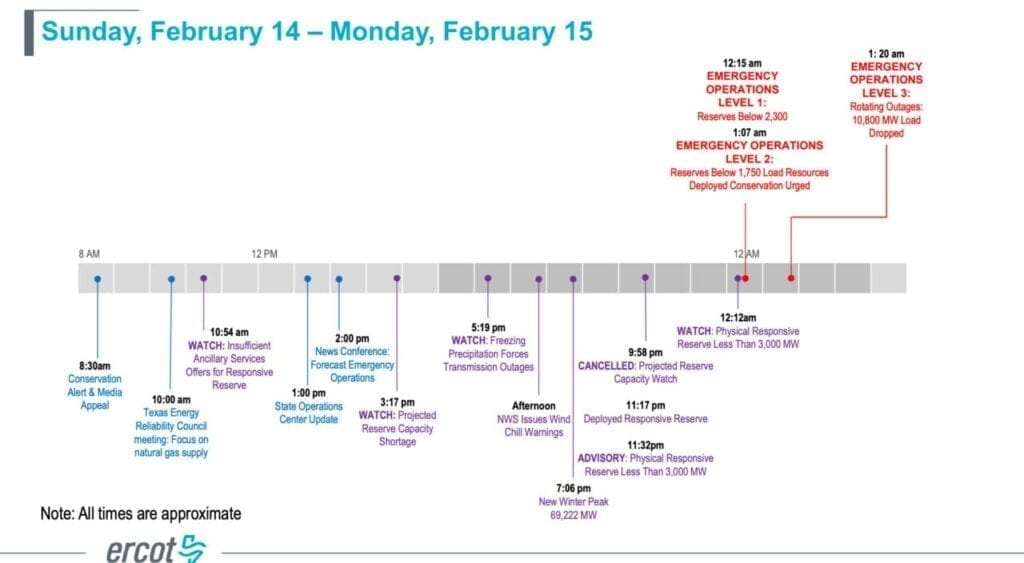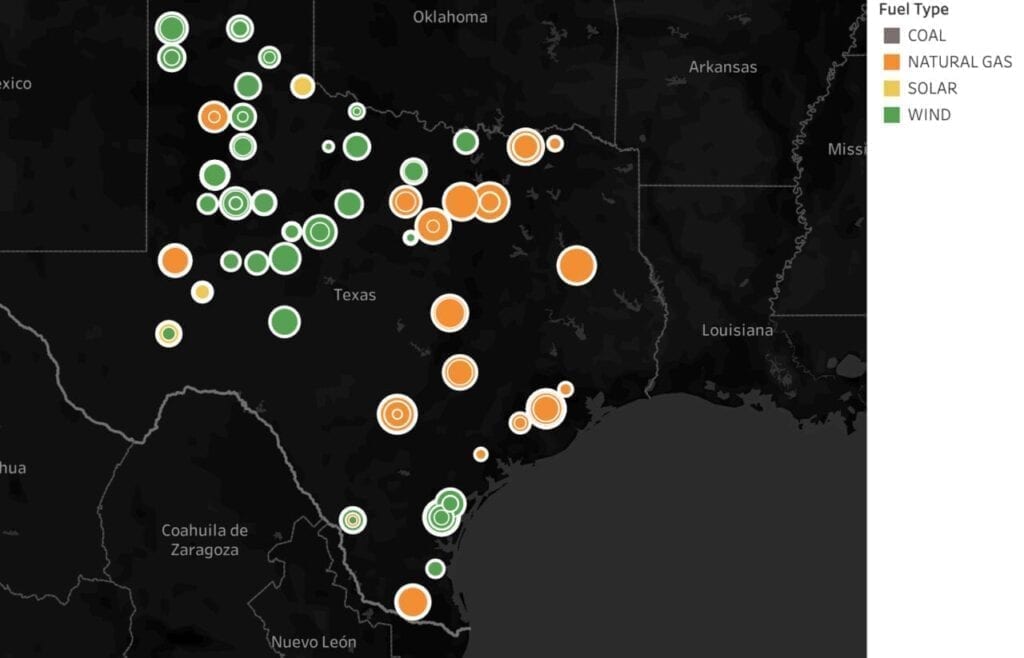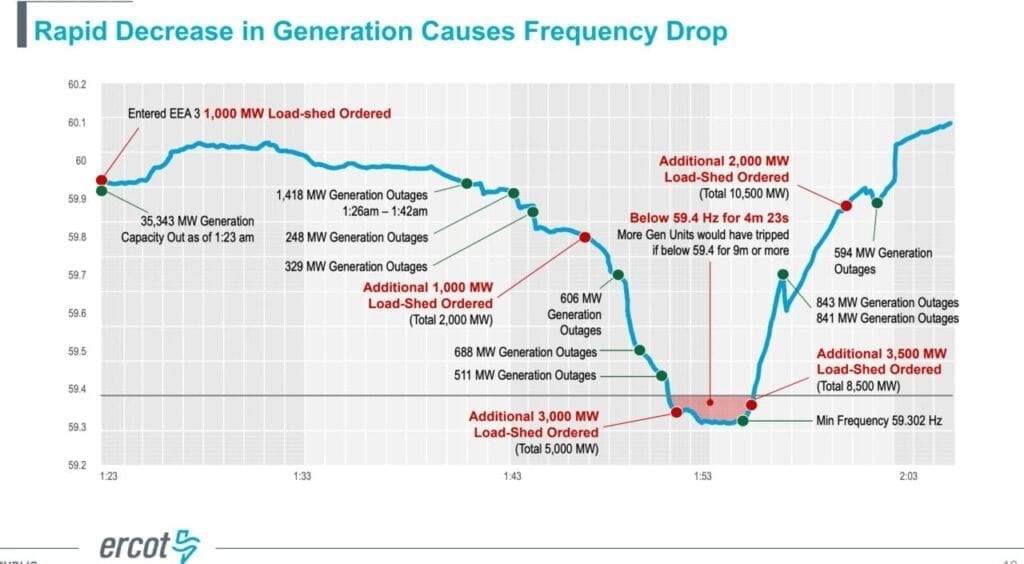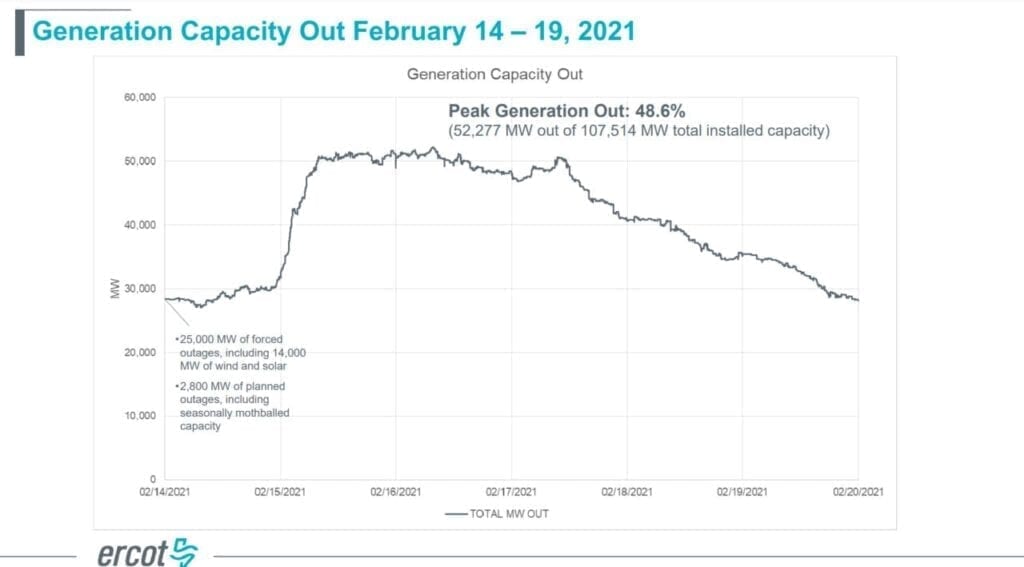ERCOT Lists Generators Forced Offline During Texas Extreme Cold Event
The Electric Reliability Council of Texas (ERCOT) in freshly revealed data on March 4 reported that the Texas grid suffered 1,796 generating or energy storage outages or derates as winter storm Uri bore down on the state in mid-February.
The grid operator made the list public in a letter it sent to lawmakers in the Texas Legislature. (A spreadsheet is available here.) The move is extraordinary for ERCOT, which typically keeps generator outage data confidential for 60 days after each applicable operating day. As Woody Rickerson, vice president of ERCOT Grid Planning and Operations, noted in his letter on Thursday, however, the measure responds to multiple requests from state lawmakers. Both houses in the Legislature have held multiple hearings over several days to uncover how the load shed debacle unfolded.
In the letter, Rickerson noted that the list “identifies each outage or derate of an ERCOT-registered Generation Resource or Energy Storage Resource that began at any point during the period of February 14-19, 2021.” Because the purpose of the list is to show which units experienced an outage during the cold weather emergency, it does not include about 28 GW that was already offline or derated as of Feb. 14, “some of which returned to service during the event,” he noted. The list, notably, also contains several blank entries for generators that have not yet granted ERCOT permission to share details of their outages, indicating the number of units that suffered incidents could be larger.
Read more: ERCOT’s board votes to oust the CEO, and state PUC says it won’t provide any relief for $16 billion in alleged overcharges for power during the storm.
ERCOT stressed the data is derived “solely on details” entered by generator owners (“Resource Entities”) into the ERCOT Outage Scheduler on or before 12:00 p.m. on Feb. 20, 2021. As such, it is “only one set of preliminary data about generator outages,” ERCOT said, noting it has issued requests for information to develop a “more comprehensive list of all resource trips and derates and the reasons for each.”
What the List Reveals
ERCOT reported on Feb. 24 that approximately 48.6% of generation was forced out at the highest point due to the impacts of various extreme weather conditions. This data visualization sources generator-reported data that ERCOT made public on March 4. Click here see a desktop-sized version of the graphic and other analyses. Source: Sonal Patel/POWER
ERCOT has said about 48.6% of generation—52.3 GW out of Texas grid’s 107.5 GW total installed capacity—was forced out at the highest point due to the impacts of various extreme weather conditions. The list names at least 312 units at 219 power plants that lost capacity for varying durations as the extreme cold event gripped the state between Sunday, Feb. 14, and Friday, Feb. 19. Of the 1,796 outage/derate incidents listed, the bulk (783) were from natural gas generation and wind (767) generation, according to POWER’s analysis of the list.
Listed natural gas generators led “megawatt reductions from outages/derates” with a total of 84,000 MW—nearly half of the 169,407 MW total—with total wind reductions coming in at 65,337 MW, followed by coal (14,878 MW), solar (3,690 MW), and nuclear (1,353 MW) from the outage at South Texas Project Unit 1. However, it suggests wind incidents lasted longer, an estimated total of 34,325 hours, versus 28,184 hours for natural gas. These preliminary insights, however, are skewed, given that the data includes 134 “blanks.”
Even if incomplete, the data provides a preliminary look at how quickly a vast range of power plants tripped offline across the state. As ERCOT’s outage data for the period suggests, several generators—mostly wind in the west and Panhandle, and gas plants in the southeast—had already begun to derate as the grid operator recorded a new winter peak of 69,222 MW at 7:06 p.m. on Sunday, Feb. 14.

At least 2.8 GW of capacity was offline for planned outages, including seasonally mothballed capacity. On Sunday, 25 GW was forced offline, including 14 GW of wind and solar, ERCOT said.

As the night wore on, more generation tripped or derated in central Texas. These include a 194-MW derate by NRG Energy’s 836-MW coal-fired Limestone plant, as well as several combined cycle gas facilities, including Panda Temple Power II, Hays Energy, and several CPS Energy facilities.
By 1:23 a.m. on Monday morning, 35.3 GW was already offline. At 1:25 a.m., ERCOT made the dire call to initiate rolling blackouts. But over the next roughly 15 minutes, another 1.4 GW was forced offline, followed quickly by the loss of 248 MW, and then another 329 MW. Shortly after 1:40 a.m., as ERCOT ordered an additional 1 GW of load shed, another 606 MW was lost, and then 688 MW, and then 511 MW. At 1:50 a.m., ERCOT fielded precipitous frequency drop below 59.4 Hz, which lasted a harrowing four minutes. It quickly ordered an additional 3 GW of load shed, bringing the total to 5 GW. By the end of the event, ERCOT would be forced to shed 20 GW of load.

A Harrowing Hour—and a Slow Recovery
POWER’s analysis suggests the bulk of the stunning generation loss between 1:15 a.m. and 1:51 a.m. came as several gas stations went black, including the 165-MW Nueces Bay plant; the 97-MW Laredo Energy plant; the 48-MW Sand Hill Energy plant owned by the City of Austin, and the 50-MW Calhoun plant in Calhoun County. The issues were compounded by an 80-MW derate at the 664-MW coal-fired Unit 5 at W.A. Parish just south of Houston at around 1:35 a.m.
Minutes later, NRG Energy’s 110-MW Wharton gas plant also powered down to just 28 MW; Calpine’s 190-MW Deer Park gas plant went black; and two GE 7HA.02 model units—the 485-MW Wolf Hollow and the 491-MW Colorado Bend CCGTs—fell offline. They were followed seconds later by another 355-MW unit at Wolf Hollow, and then the loss of the 181-MW Channelview gas plant in Harris County; the 165-MW Barney Davis gas plant; and a complete loss of power from the 428-MW Decker Power gas plant near Austin.
This timeline of reported generator outages shows which outages/derates occurred leading up to the emergency alert declaration—and subsequent load shed—on 1:23 a.m. on Feb. 15. The yellow highlight marks the EE3 period. A desktop-sized version of the visualization is here. Source: Sonal Patel/POWER
But just as ERCOT was recovering from the frequency drop, the 933-MW coal-fired Sandy Creek plant went dark at around 1:58 a.m. At 2:08 a.m., Colorado Bend lost another two 360-MW units, and three 141-MW units began tripping at Calpine’s Corpus Christi Energy facility. At 2:20 a.m., the 836-MW Limestone coal plant lost all its power.
In the backdrop, wind facilities were falling offline, too. Between 1 a.m. and 2:30 a.m., the 100-MW Karankawa facility in San Patricio country stopped churning; it was followed by the 90-MW Blue Summit facility, and then two 100-MW units at the Baffin Wind facility, and the massive 200-MW Los Vientos facility. The 202-MW Mesteno wind facility in Starr county also partly powered down.
Between 2:30 a.m. and 5 a.m. on Monday night, plants kept dropping offline, among them, one of Texas’s only hydro power plants—the 50-MW Dow plant in Brazoria county—and 16 gas units. In total, nearly 3 GW of gas and 1.6 GW of wind seasonal maximum capacity dropped off in that period. But shortly after 5 a.m., two other massive generators tripped: a 577-MW coal unit at the W.A. Parish plant, and 1.3 GW of nuclear capacity from the South Texas Project Unit 1. STP in February told POWER the automatic trip at the nuclear unit resulted when a small diameter sensing line “apparently froze and created a false signal to [STP 1’s] feed pumps that caused the pumps to trip.” It was the unit’s first trip since May 2016.
STP’s trip—which would last more than 60 hours—appears to have accelerated the generation loss to a peak that ERCOT would navigate for two more days, and Texans, bereft of power and water, would painfully endure.

Generators Had Multiple Outages
Along with chronicling generator outages, ERCOT’s data reveals the grid’s struggle to return to normal.
As this visualization shows, many generators suffered multiple outages, and when some were able to restore service, others dropped offline. Owing to moderating temperatures on Wednesday, ERCOT secured a small net gain in generation, and it continued that generation through Thursday. The grid operator canceled the Level 3 Emergency Alert on Feb. 18, Thursday, at 12:42 a.m., and it returned to normal operations on Friday at 10:30 a.m.
This visualization shows which generation owners suffered multiple outages. The columns on the right provide a timeframe for outage starts and ends. A desktop-sized version of the visualization is here. Click here for a multiple-page PDF of the graphic. Source: Sonal Patel/POWER
The named outages/derate incidents, meanwhile, were a chaotic mix that affected every resource on the grid. This visualization breaks down incidents by generation owner, station name, and outage/derate incident duration.
Note: This information is based on ERCOT’s public data. ERCOT cautions that the data “may not accurately reflect the operating state of each generator.” It also notes the data may not include outages that are less than two hours in duration because resource entities are not required to enter those in the ERCOT Outage Scheduler. POWER has reached out to ERCOT to understand inconsistencies. A desktop-sized version of the visualization is here. Click here for a multiple-page PDF of the graphic. Source: Sonal Patel/POWER
Finally, ERCOT’s data, sorted by resource entity is available here:
—Sonal Patel is a POWER senior associate editor (@sonalcpatel, @POWERmagazine).